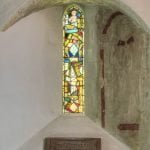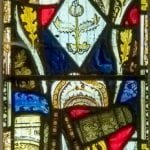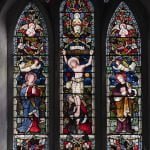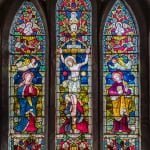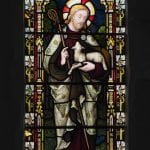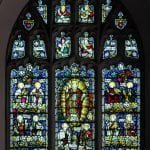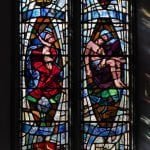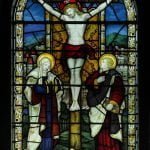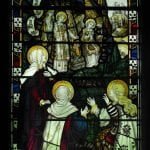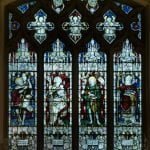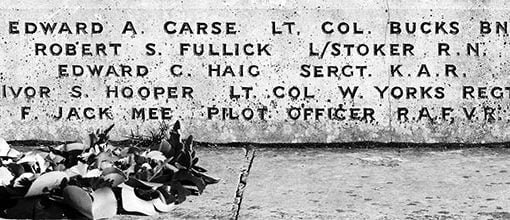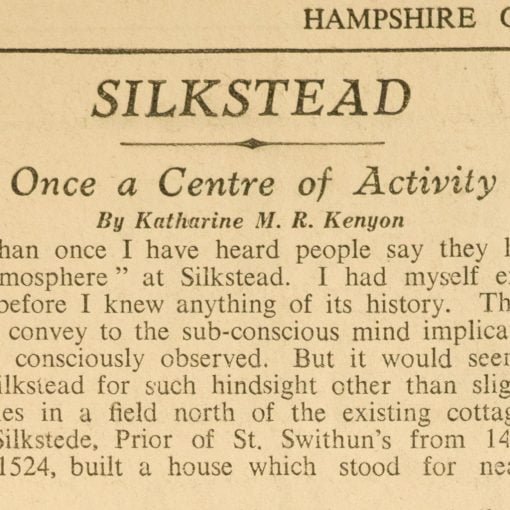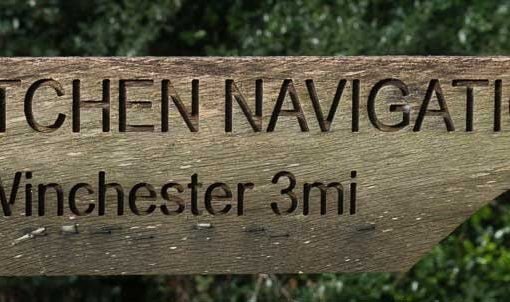Table of Contents
All Saints Compton Stained Glass Windows
In preparation
- Thirteenth-century lancet in the north wall of the old church, still showing the painting of a bishop, possibly Thomas Becket. Also visible is the carved oak tablet, designed by G.H Kitchin, in memory of his younger brother Brook Taylor Kitchin who lived in Yew Tree Cottage for many years.
- Detailed view of the fragments of glass, some 15c, which make up the lancet window.
- This window, the main east window in the old Norman aisle of Compton church, was given by Mrs Simeon in memory of her grandfather Philip Williams, rector 1781-1830.
- Another view of the main east window in the old Norman aisle of Compton church, given by Mrs Simeon in memory of her grandfather Philip Williams, rector 1781-1830. The inscription at the bottom of the window is hidden from normal view by the 1940s Kitchin-designed panelling commemorating two more recent rectors: Cecil Cooper and Philip Cunningham. To see the inscription, you have to use a step ladder to get a view over the top of the panelling. Given that the records show that Philip Williams was rector for almost 50 years, it’s not clear why this window says he was rector for 30 years. Either it’s a simple mistake, or it reflects the fact that he didn’t actually live in the village until about 1800
- This window is in the north wall of the sanctuary of the 1905 extension to All Saints’ Church, Compton. A plaque notes that it was rebuilt from the south wall of the old Norman church.
- All Saints’ Compton, the memorial window to Charles Wickham, rector for over 30 years, from 1871 to 1902. This window was relocated from the old south wall to the new south wall when the church was extended in 1905.
- The east window in the 1905 extension to All Saints’ Church, Compton, by “Master of Glass” C.E.Kempe, 1906. Donated by churchwarden John Atkinson Pearson.
- Twin panels of the Mother and Child and a pieta, in memory of Edwin Ernest Summer Utterton (1876-1961), army chaplain during the first world war, rector of Compton 1940-1951, and great-nephew of Mary Sumner, founder of the Mothers’ Union.
- Memorial to George Fawkes, Rector 1958-1973
The Utterton Memorial window
Edwin Ernest Sumner Utterton (1876-1961) was rector of Compton from 1940 to 1951. He had served as an Army Chaplain during the Great War.
We are advised that the 1963 Utterton Memorial window uses opaque white glass, of the kind first used in Venice to produce an imitation porcelain or mother-of-pearl effect, and used extensively by Tiffany.
The window, showing the Madonna and child, and a pietà, is by James Powell & Sons, designed by Brian Thomas.
Some notes concerning the Utterton Memorial window
Transcribed from the plaque under the Utterton window, amended to show the correct relationship between Mary Sumner and Edwin Utterton.
The Reverend Edwin Ernest Sumner Utterton was the great-nephew of Mary Sumner, founder of the Mothers’ Union; and the theme of his memorial is motherhood, exemplified in the Mother of Jesus.
The panel of the Madonna and Child is surmounted by an emblem of lilies, a crown and a star, and that of the Pietà, the Mother with the body of her crucified Son, by the emblem of the pierced heart (St Luke II, 35).
The Latin inscription is a line from the hymn – “Stabat Mater” – “Lo, the Mother, fount of love” – of which a very free translation appears as hymn 118, A&M Revised.
At the bottom of the window, surmounting the memorial inscription are the arms of the Utterton and Sumner families. The window was designed in 1963 by Mr Brian Thomas. In it can be discerned the influence of Robert Bridges, Poet Laureate 1913 to 1930:-
‘twas well when Art
fashioning a domestic symbol in worship of Christ
pictured him as an infant in his Mother’s arms,
sharing with her his suffering and glory – it was well:
Nor count I any scripture to be better inspired
with eternal wisdom or by insight of man
than the four words wherewith the sad penitent hymn
calleth aloud on Mary standing neath the cross:
EIA MATER, it saith, MATER FONS AMORIS.
The Testament of Beauty, Book II, 155-163
The Fawkes Memorial Window
At the west end, the plain window commemorates Rev George Fawkes, Rector 1958-1973, who died in 1990. , The windows shows this verse from a well-known hymn by George Herbert:
“A man that looks on glass,
On it may stay his eye;
Or, if he pleaseth, through it pass,
And then the heaven espy”,
and
“For all who are led by the Spirit of God are sons of God” (Romans 8.14).
George, a retired naval chaplain, was married to the redoubtable Diana Fawkes née Weir; athlete, linguist, and long time cathedral guide.
Charles Eamer Kempe
The Kempe East Window
Saints shown, many with a local connection, are, reading from bottom to top:
Left light: St Alban and St Birinus, St Stephen and St Agnes, St Peter and St Paul
Centre light: St Augustine, St Edward the Confessor
Right light: St Benedict and St Swithin, St Mary Magdalene and St Catherine, St John and St Andrew.
Dedication:
The dedication at the bottom right of the window reads:
In honour of our Lord Jesus Christ, the True Vine, and of His Saints, and in grateful remembrance of those who have departed hence in the Lord, James Atkinson Pearson, xxv years Churchwarden of this Parish, dedicates this window. A.D. mcmvi.
Mr. Pearson served for 50 years as churchwarden and died in 1936.
Notes
Kempe is rated by many as the foremost designer of stained glass in the late Victorian era. You can find his work in many churches and cathedrals throughout England and Wales.
Born at Ovingdean Hall, near Brighton, East Sussex in 1837, he was educated at Twyford School and Pembroke College, Oxford.
He considered becoming a priest. But when it became clear that his severe stammer would be an impediment to preaching, he decided that if he could not minister in the sanctuary he would use his talents to adorn it.
He was a close friend of William Morris, Burne Jones, Madox Brown and Rossetti, whose influence can be seen in his work.
His trademark, a small wheatsheaf, appears in (almost always) the bottom left-hand corner of his windows.
There are six windows in Winchester Cathedral from the studio of C.E.Kempe: the three windows in the Lady Chapel, the east window in the Bishop Langton burial chapel, the Jane Austen window, and the window commemorating the centenary of the Rifle Brigade.
There are two in each of Dummer, Chawton and Upham churches, one in Lyndhurst, Compton, Overton and Twyford School chapel.
And many more throughout Hampshire.
Kempe died suddenly on 28 April 1907 aged 69, and was buried in the churchyard of the little early Norman church of St. Wulfran’s, Ovingdean.
After his death, his firm was reformed as C. E Kempe & Co. Ltd.
Kempe’s distant cousin, Walter Earnest Tower (1873–1955) became Chairman. If you should see a window with a wheatsheaf superimposed by a small tower, it means that it was designed after Kempe’s death.
Examples of work by C. E Kempe & Co can be seen in the little church of Farley Chamberlayne, and in the Winchester Cathedral window which commemorates those Kings Royal Rifle Corps members who fell in the South African War of 1899-1902.
Based on original notes by M.M.P. (Margaret Pooley)
Other local works by Kempe
- East Window at St Johns Farley Chamberlayne.The tower superimposed on Kempe’s trademark wheatsheaf marks this out as a product of C.E.Kempe & Co Ltd., the company formed after Kempe’s death in 1907 to carry on his work. Kempe’s cousin, Walter Tower, was chairman of the company.This window commemorates two past rectors of the parish: Thomas Woodham, who served for 56 years, and his son William.
- North Window at Farley Chamberlayne. The second of two windows by C.E. Kempe & Co Ltd. in the sanctuary of St. John’s Church.
- The 1903 (liturgical) West Window in Twyford School Chapel by former pupil Charles Eamer Kempe, commemorating headmaster Latham Wickham.
See also
- The Kempe Trust http://thekempetrust.co.uk/
- The stained glass of Charles Eamer Kempe by Adrian Barlow
- Wikipedia entry Charles Eamer Kempe
- stainedglassrecordings.org.uk details of stained glass at All Saints Compton, Hampshire
- Broken Lights – an article about the lancet window of mediaeval glass fragments in the old church, reproduced from the July 1930 Parish Magazine.

